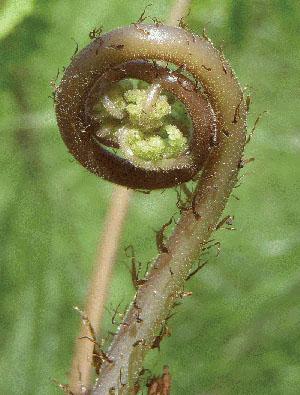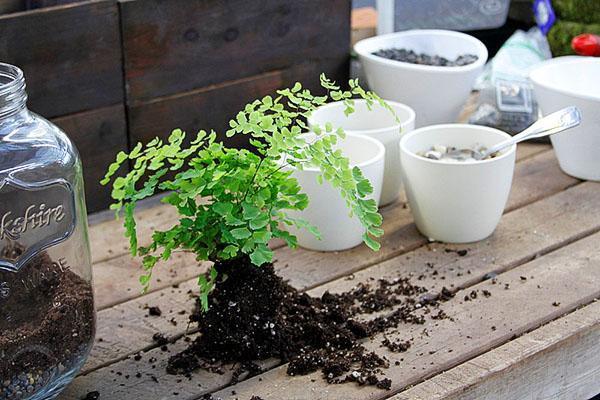What care does indoor fern need?
 Ferns are among the oldest representatives of the plant kingdom, they survived dinosaurs, witnessed human evolution, and today they successfully grow not only in nature, but also indoors. The attention to the plant on the part of flower growers can be explained by the beauty of figuratively cut leaves and the fact that caring for indoor fern at home is not difficult at all.
Ferns are among the oldest representatives of the plant kingdom, they survived dinosaurs, witnessed human evolution, and today they successfully grow not only in nature, but also indoors. The attention to the plant on the part of flower growers can be explained by the beauty of figuratively cut leaves and the fact that caring for indoor fern at home is not difficult at all.
All over the planet today there are about 10 thousand species of ferns, but in the collections of indoor plant lovers, of course, there are fewer varieties. The most unpretentious and at the same time ornamental plants fall on the windowsills. Among them davallia,asplenium, pteris, nephrolepis and other species from different parts of the world.
Fern structure
Occupying an intermediate position between mosses, algae and gymnosperms, ferns have retained the features of the oldest representatives of the flora and at the same time have successfully adapted to life in conditions that have changed over millions of years.

As they grow back, they unwind, become darker and denser. Fern rhizomes are located under the soil layer.
How to care for a fern at home?
When caring for indoor ferns at home, they try to create a microclimate that is as similar to natural as possible. This fully applies to:
- air temperature at different times of the year;
- humidity of the environment;
- lighting;
- frequency and volume of watering;
- making dressings;
- transplants.
 Most of the indoor ferns grown indoors, as shown, are from the tropics or subtropical regions of the planet. But there are also indigenous inhabitants of temperate zones. To adapt to the needs of plants, all ferns are protected from drafts and sudden changes in temperature, as well as protected from the scorching sun.
Most of the indoor ferns grown indoors, as shown, are from the tropics or subtropical regions of the planet. But there are also indigenous inhabitants of temperate zones. To adapt to the needs of plants, all ferns are protected from drafts and sudden changes in temperature, as well as protected from the scorching sun.
Depending on the species being grown, they try to maintain an acceptable temperature. In summer, plants can withstand heating up to 28-30 ° C, but subject to other conditions of care and increased attention from the owner.
 How to care for a fern if this maximum is exceeded? The plant will need not only the usual protection from direct sunlight, but also frequent irrigation on especially hot days. Filling the entire free volume of the pot with moist sphagnum or placing the flower in a moist florarium will help. A useful solution would be to relocate the fern for the entire warm period under the open sky.
How to care for a fern if this maximum is exceeded? The plant will need not only the usual protection from direct sunlight, but also frequent irrigation on especially hot days. Filling the entire free volume of the pot with moist sphagnum or placing the flower in a moist florarium will help. A useful solution would be to relocate the fern for the entire warm period under the open sky.
But with the onset of autumn, even before the first frost, the grower will have to find a cool place for the green pet under the roof. Some species are content with keeping at normal room temperature not lower than 17 ° C. But there are those who are more comfortable at 14-16 ° C. The minimum allowable temperature of the content is +10 ° C, if the air is colder, it threatens with hypothermia of the rhizomes, which is especially dangerous in wet soil.
At home, caring for an indoor fern will be greatly simplified if the pot is placed on the east or west window. Here, the plants are not threatened with sunburn, and the incoming lighting is sufficient for active growth and maintaining decorativeness.
Do not forget that all members of the family react negatively to air pollution, smoke, car exhaust. Therefore, not the best place for a flower is a smoker's room or a balcony overlooking a noisy street with heavy traffic.
 The frequency and intensity of watering varies with the season. When an indoor fern, as in the photo, is actively growing, it is watered more often, a decrease in growth rates signals the need to moisten the soil less often.
The frequency and intensity of watering varies with the season. When an indoor fern, as in the photo, is actively growing, it is watered more often, a decrease in growth rates signals the need to moisten the soil less often.
For ferns, both excessive and poor watering is harmful. The first case threatens with compaction and acidification of the soil, a decrease in the intensity of respiration and nutrition of the plant. Although the roots do not die, the flower quickly passes into a depressed, weakened state.
 Dryness of the substrate leads to the death of the leaves. Do not expect that those who have lost their turgor and bright color of frond will revive after renewal glaze. Even with the resumption of proper care, they die off, which negatively affects the appearance of the flower.
Dryness of the substrate leads to the death of the leaves. Do not expect that those who have lost their turgor and bright color of frond will revive after renewal glaze. Even with the resumption of proper care, they die off, which negatively affects the appearance of the flower.
How to care for a fern that has lost its entire aerial part at home? It is possible to revive a plant affected by drought by knowing the intricacies of the fern development cycle. Both already dead and still remaining green fronds are removed from the plant, after which the pot is transferred to a well-lit windowsill. With regular, but not too abundant watering, the fern can quickly recover. And a sign of awakening will be the tight green spirals of new foliage that have appeared over the substrate.
Complex fertilizing with the inclusion of organics and minerals effectively helps to maintain plants. They are carried out on a regular basis from mid-spring to autumn.
Pot fern transplant
 The best time to transplant indoor fern is spring. Depending on the type of home plant, the procedure may have its own characteristics.
The best time to transplant indoor fern is spring. Depending on the type of home plant, the procedure may have its own characteristics.
Since among the ferns there are not only terrestrial plants, but also epiphytes, you will have to prepare for this stage of caring for indoor ferns at home in advance. To do this, select:
- a suitable pot, basket or piece of wood for epiphytic varieties;
- a loose, necessarily light substrate that meets the needs of the culture.
 Although stores offer ready-to-use mixes, for most home grown plants, it is best to ask your pet further. For example, for epiphytes, it is preferable to add large fragments of fallen wood, steamed bark, moss to the soil, and natives of the tropics require the inclusion of more nutrients in the soil.
Although stores offer ready-to-use mixes, for most home grown plants, it is best to ask your pet further. For example, for epiphytes, it is preferable to add large fragments of fallen wood, steamed bark, moss to the soil, and natives of the tropics require the inclusion of more nutrients in the soil.
Fern breeding
Everyone is familiar with the folk tales about the fern flower that brings wealth and good luck. It is possible to find an unprecedented miracle by no one only during one, the shortest night of the year, when the fern blooms. And although the heroes of fairy tales managed to get a magic flower, in reality no one is destined to repeat their feat!
 Due to their structure, ferns do not bloom. But how does a fern reproduce? The fact is that ferns have retained one of the oldest ways of obtaining offspring through spores.
Due to their structure, ferns do not bloom. But how does a fern reproduce? The fact is that ferns have retained one of the oldest ways of obtaining offspring through spores.
At home, it is used extremely rarely because of the laboriousness and long wait for tiny plant rudiments to hatch and mature. But reproduction by spores cannot be replaced when it comes to growing especially rare species.
 Reproduction of ferns by spores begins with the formation of sporangia on fronds containing haploid spores. Ripening, they crumble into nearby soil areas, are carried by the wind and animals and, falling into a favorable environment, germinate.After fertilization, the life of a new fern begins, but it can take up to several years before the formation of a self-feeding plant, depending on the species.
Reproduction of ferns by spores begins with the formation of sporangia on fronds containing haploid spores. Ripening, they crumble into nearby soil areas, are carried by the wind and animals and, falling into a favorable environment, germinate.After fertilization, the life of a new fern begins, but it can take up to several years before the formation of a self-feeding plant, depending on the species.
In room conditions, the division of adult specimens is carried out. It is best to undertake a rather unpleasant procedure for the plant in the spring, combining it with a transplant into fresh soil.
The fern is divided into separate sockets so that each one has:
- a few leaves;
- own point of growth;
- an area of rhizome sufficient for growth.
 There are many ways to breed ferns. Individual varieties are easy to propagate by dividing underground shoots. Others give an increase in a peculiar mustache. And the third ferns, in order to accelerate growth and provide their offspring with a better chance of survival, became viviparous. They form daughter rosettes right on the fronds. When the embryos are old enough to lead their own lives, they crumble and take root.
There are many ways to breed ferns. Individual varieties are easy to propagate by dividing underground shoots. Others give an increase in a peculiar mustache. And the third ferns, in order to accelerate growth and provide their offspring with a better chance of survival, became viviparous. They form daughter rosettes right on the fronds. When the embryos are old enough to lead their own lives, they crumble and take root.
Hello! Tell me what's wrong with this fern? It grows very slowly. The leaves are crooked and small. Thank.